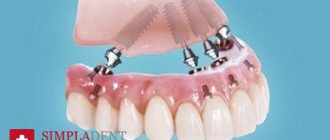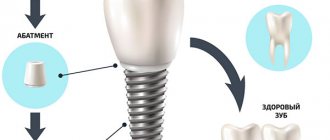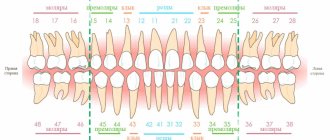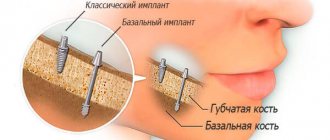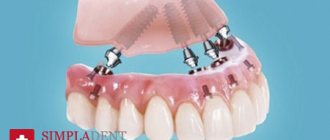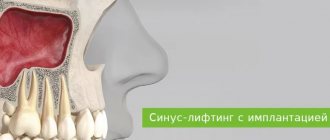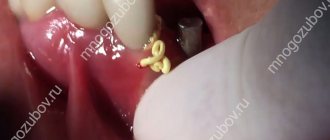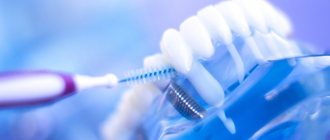Single-stage dental implantation is the implantation of a titanium root into the bone immediately after the removal of your tooth. In this case, bone augmentation is not required (as with the classical scheme), since after the removal of one’s tooth, the volume of hard tissue is quite sufficient. The procedure for implanting a titanium pin is performed in one visit to the dentist, but the patient will still have to visit the office several times: for diagnostics, replacing the temporary crown with a permanent one, and monitoring the healing process.
What is single-stage implantation?
Among the wide range of implantation services, one-step dental restoration procedure is becoming increasingly popular.
It involves installing a dental implant into the socket of a newly extracted tooth. This means that the prerequisite for the procedure is the presence of the tooth, followed by tooth extraction and implant placement in one visit. Operation
Medium difficulty
There are contraindications
Doctor's qualifications
High
How to choose a clinic
The success of the procedure largely depends on the qualifications of the doctor and the level of services provided. The Saint-Dent Clinic has extensive experience in installing single-stage implants. By contacting us, you receive the following benefits.
- Modern equipment for research and manipulation.
- High-quality implants from European manufacturers.
- Individual approach to each patient.
- Personal support at all stages of treatment.
- Detailed costing of services.
With us you will receive comprehensive dental care at reasonable prices.
What methods of immediate implantation exist?
Representing the installation of a titanium implant into the gum bone tissue, implantation into the socket of an extracted tooth can be of two types:
- After the tooth is removed, an implant is installed, around which the gum tissue is sutured. Subsequent manipulations, namely the installation of an abutment and crown, are performed only after complete healing of the gums and osseointegration of the implant (according to the classic protocol).
- After removal, a monoblock implant is installed, on which a crown is placed.
Work examples
How often do you visit the dentist?
Stages of treatment
At the first stage, tooth extraction is performed. It is important that the procedure is performed without causing major damage to the surrounding bone, otherwise it will complicate healing. The removal process is necessarily preceded by an x-ray, which is necessary to clarify the number of roots and their location. Implantation will be possible only if the size of the hole is comparable to the dimensions of the prosthesis.
At the second stage, the implant is installed in the socket and, if necessary, additionally fixed with bone material. Next, the abutment is screwed on and a temporary plastic crown is put on.
At the third stage, after 4-6 months, the temporary crown is replaced with a permanent one.
What are the contraindications to immediate dental implantation?
Despite the popularity of this method of restoring dental aesthetics and functionality, there are a number of reasons why single-stage implantation is impossible.
- Missing tooth. Regardless of whether the tooth was removed two years ago or two weeks ago, it will be impossible to carry out immediate implantation. Only a fresh socket of a barely extracted tooth is suitable for installing a titanium “root”.
- Inflammation of the gum tissue in the area of the tooth that will be removed. The inflammatory process is likely to cause implant failure in the future. In this situation, after removal, complete healing of the hole is necessary and only then can the implant be installed.
- Uncompensated diabetes mellitus.
- Bruxism (teeth grinding that a person cannot control during sleep).
- The period of exacerbation of chronic diseases.
- Heavy smoking.
- Alcoholism.
- Nervous disorders.
There are cases when immediate installation of a dental implant is possible, but immediate loading with a crown is contraindicated. An example is a too traumatic tooth extraction procedure and severe damage to soft tissues.
It is important that an experienced doctor decides on the possibility of installing a crown directly on the implant. This possibility is due to the good condition of the oral cavity, the absence of any problems - carious lesions, problems with the gums, etc. Otherwise, there is a risk of rejection of the “root”. Thus, the accumulation of plaque around injured and unsutured gum tissue is the reason for the occurrence of reimplantitis (inflammation of the bone tissue around a metal implant).
Stages and timing of one-stage implant installation
Simultaneous dental implantation allows you to preserve the natural physiological state of tissues: the volume of bone and mucous membrane. In order for dental restoration to be successful, it is necessary to follow surgical technologies (protocols) developed specifically for this type of intervention.
Preparation
Before undergoing immediate dental implantation, the patient must undergo a thorough examination. To do this, we consult a dental surgeon. He interviews the patient about complaints and existing diseases (nothing can be hidden, since some chronic diseases or taking certain medications can interfere with the implant’s healing), examines the oral cavity and the damaged tooth, and then sends the patient for additional examination:
- laboratory tests - general blood test and blood clotting test (coagulogram);
- instrumental studies : orthopantomography (OPTG) - a survey image of the jaw, allowing to assess the general condition of the dental system;
- computed tomography - allows you to identify the volume and density of bone tissue, as well as the thickness of the mucous membrane in the area of the damaged tooth.
The entire examination is carried out within one day, after which the doctor decides whether single-stage implantation is suitable for the patient, what type of implantation should be used, and draws up a surgical plan.
Anesthesia and tooth root removal
First, local anesthesia is performed. Technique – infiltration carpule anesthesia. The periodontal tissues are impregnated with anesthetic using a special carpule syringe with a medication ampoule placed on the side and a very thin disposable needle. It is painless for the patient and convenient for the doctor.
It is very important to carefully remove the root of a damaged or injured tooth, since immediate implantation can only be carried out if there is an intact bone socket and the absence of an inflammatory process in the area of the apex of the tooth root.
Implant installation
Stages of one-stage simultaneous dental implantation in one visit
This stage also has its own characteristics and depends on the type of implant, pre-selected by the doctor in accordance with the density and volume of the jaw bone. The installation consists of the following actions by the surgeon:
- Gum incision is not required if the socket of an extracted tooth is used for implantation. Our doctor treats it with a simultaneous examination: it is important that the bone septa and mucous membrane are intact.
- Implant installation . It is necessary not only to install the selected implant, but also to make it as stable as possible without damaging the surrounding tissue. If the bone is dense and its volume is sufficient, then the titanium rod is simply screwed into the bone and occupies the entire space of the hole. But if the hole is wide and the bone is not dense enough, then artificial bone tissue is inserted into the hole to stabilize the pin. Sometimes there is a need to increase bone volume using a gentle closed sinus lift operation.
- Attaching the crown . The temporary crown is attached to an abutment protruding above the gum. Its height is slightly lower than that of the crowns of adjacent natural teeth, in order to prevent high load on the titanium pin during the period of its implantation (osseointegration). After installing the temporary crown, no suturing is required. The entire operation takes about an hour. If a closed sinus lift is performed at the same time, then everything will take 2-3 hours.
- Osseointegration - lasts 4-5 months when implanted in the upper jaw (the bone is less dense) and about 2 months in the lower jaw, after which the temporary crown is replaced with a permanent one, made of the material most suitable for the patient (ceramics, metal-ceramics, zirconium).
Recommendations for oral care
After immediate dental implantation, you must follow all doctor’s recommendations.
On the first day after implantation:
- immediately after the operation it is better to be in a semi-vertical position - sitting or reclining, so that the head is higher than the body; You also need to sleep on a high pillow - this prevents the formation of swelling and associated pain;
- to avoid problems with the appearance of postoperative swelling, periodically apply cold to the cheek during the first 2–3 hours, for example, a napkin moistened with cold water; Do not heat the cheek over the surgical site;
- You can drink after 3 hours and only unsweetened, non-hot drinks; exclude coffee and strong tea;
- 5 hours after the operation, you can eat semi-liquid, mushy food that does not contain a lot of salt, without sugar and hot seasonings;
- if there is pain, you can take a painkiller, for example, a Paracetamol 500 mg tablet;
- active rinsing of the mouth with antiseptics is not recommended due to possible mechanical damage to the periodontal tissues; instead, make baths with antiseptics, for example, with a furatsilin solution: take a mouthful of the solution and hold for a minute;
- do not smoke or reduce smoking to a minimum - narrowing of blood vessels occurs, impairing healing and osseointegration.
During the period of osseointegration:
- during the first month you should not take a bath or sauna or visit the pool;
- avoid heavy physical activity and prolonged stress - all this reduces immunity and delays implantation;
- do not smoke or limit smoking, as well as the consumption of alcohol, strong tea and coffee;
- do not eat too hard, spicy, hot or cold foods;
- chew mainly on the healthy side, gradually increasing the load at the operation site;
- Do not forget about the need for good nutrition.
After installing a permanent crown, gradually increase the load on the implant and strictly adhere to the rules of oral hygiene.
Hygiene procedures:
- for the first 3 days after surgery, do oral baths with antiseptics twice a day;
- after 3 days you can brush your teeth with a soft toothbrush twice a day;
- After 2 weeks, you can start using special devices for washing teeth and removing food debris - irrigators.
If there are no complications, you can return to standard oral hygiene procedures 2-3 weeks after surgery.
How is one-stage implantation performed?
The algorithm for performing one-stage dental implantation is as follows:
- An examination of the condition of the oral cavity is carried out. If any problems are identified - carious lesions or inflamed areas of the gums - it is necessary to carry out appropriate treatment.
- Hygienic teeth cleaning is carried out.
- The tooth is removed.
- The hole is cleaned and treated with special compounds.
- The implant is installed.
- If necessary, special bone material is used to increase the strength of implant fixation.
- According to the doctor's decision, an abutment or temporary crown is installed.
All these stages are “fitted” into one dental visit. After which the patient will have to take full responsibility for the healing process and compliance with the rules of the rehabilitation period.
Postoperative period
After installation of the implant, swelling and a slight increase in temperature may be observed. Doctors recommend observing the following conditions.
- Avoid chewing load.
- Do not consume hot food or drinks.
- Carefully monitor oral hygiene.
- Reduce physical activity and avoid stress.
- Avoid traveling by plane.
- Eliminate alcohol and tobacco.
Where to go for treatment
Implantation immediately after tooth extraction has become a common option today to solve the problem. The implant is placed in place of the tooth during the same visit as the extraction. Relatively often, the missing bone around the implant (which, as a rule, is narrower than the root of a natural tooth) must be supplemented with a special biomaterial. In case of extensive bone damage caused by inflammatory processes in the teeth, such treatment is not always possible.
In everyday dental practice, doctors are often faced with the need for removal, including in emergency cases. The method of immediate implantation and, if possible, immediate loading should then be chosen. If, of course, all the requirements are met - there is enough bone tissue, the bone is not too damaged during tooth extraction, etc. Of course, modern dentistry provides other opportunities to help the patient restore extracted teeth. Nevertheless, implantation has many advantages - the highest aesthetic effect and improvement in the patient’s quality of life.
Consult the best specialists in implantology in the capital about dental restoration using a one-step protocol.
| Clinic address | Clinic | Price |
| Dentistry ROOTT |
|
| Moscow, Kolpachny lane, 6, building 4. | Dentistry Sandora |
|
| Dentistry Prosmail.RU |
|
| Moscow, metro station "Butyrskaya", Rustaveli Street, building 15 | Dental Clinic Dention |
|
| Moscow, metro station Barrikadnaya st. Zoologicheskaya, 2, under. 9 | Dentistry DENTAL DREAM |
|
| Moscow, Zvenigorodskoye sh., 7 | Dentistry Implant Expert | Nobel implantation, USA, from 50,000 rubles, Astra Tech implantation, Sweden from 47,200 rubles, OSSTEM Korea - 27,000 rubles |
| Moscow, Bolshoi Sergievsky lane, 5 | Dentistry Viva-dent | Dental implantation depending on complexity: 31,000 - 41,000 rubles per 1 tooth |
| Moscow, st. Molodtsova, 2a | Family discount dentistry | Implantation is carried out using various systems - Astra Tech (Sweden), Ankylos Densply (Germany), Dentium (Korea), the price for 1 restored tooth is from 30,000 rubles. |
| Moscow, Paveletskaya sq., 1 | Dental Clinic Denta VIP | Implantation of the IMPLA system (Germany), OSSTEM (Korea) - from 36,000 rubles. Astra Tech (Sweden) – from 45,000 rubles. |
| Moscow, st. Lyublinskaya, 161 | Dentistry PRESIDENT |
|
Technique of the procedure
After the tooth is removed, an implant is placed into the resulting cavity. If necessary, the empty space is filled with bone material, which improves the fixation of the future prosthesis. This method has a very high percentage of engraftment, allows you to quickly restore aesthetics, and is performed under one anesthesia.
The abutment adapter is immediately screwed onto the implant, and a temporary prosthesis is installed on it, which performs only an aesthetic function. After 4-6 months, when the titanium pin has completely taken root, a permanent crown is fixed.
Advantages of the method
- Restoring the aesthetics of the dentition in one visit to the clinic (when installing a temporary crown)
- Reducing patient rehabilitation time
- Possibility to give immediate load when installing a lightweight prosthesis
- Reducing the number of surgical interventions
- Preservation of the natural gum contour
- Preventing atrophy and loss of bone tissue that occurs during the long-term absence of a dental element
Important: the possibility of using this technique for a particular patient is determined by the implantologist only after a hardware examination. If it is impossible to implement this technology, the specialist will offer a classic option.
The dental network offers services for immediate dental implantation. Our implantologists have high medical qualifications and regularly improve their skills in leading Russian and foreign clinics. The quality of services meets international standards. We have a system of family and cumulative discounts. If necessary, we provide reporting documents for filing tax deductions.
Branches of our orthodontic center are located in Moscow within walking distance from the metro:
- Art. Alekseevskaya (VDNKh district, etc. Mira), address: st. 3rd Mytishchiskaya house 3, building 2;
- Art. Shelepikha, address: Shelepikhinskaya embankment, address: building 34, building 1.
We will be able to restore the integrity of the dentition in one visit to the clinic, come and see for yourself. We are waiting for you!
Risk of implant rejection
Such strict and numerous contraindications are prescribed to minimize cases of titanium implant rejection. Statistics say 2-4%, and this is a very small figure. But doctors are trying to completely exclude it.
The risks of implant rejection with a one-step technique may include:
- poor removal and severe trauma to the gums;
- plaque in the oral cavity - not only on the teeth, but also on the mucous membrane around the hole;
- weak fixation of the implant - porous bone tissue or other prerequisites;
- incorrect selection of a temporary crown and excessive load on the implant.
Which implants are suitable?
We use three types of ROOTT implant systems:
- classic two-part ROOTT FORM;
- monolithic one-piece ROOTT BASAL;
- one-piece compression ROOTT COMPRESSIVE.
ROOTT FORM systems are installed in the upper layer of the jaw, so when bone tissue atrophies, it is replenished with bone material. The product consists of a titanium root without an abutment. After the implant is implanted, it is closed with a plug and sutures are applied. 3-5 months after surgery, a gum former is placed. After 10-14 days, an abutment is attached in its place, onto which the crown is placed. It is fixed with a screw or with cement.
The BASAL and COMPRESSIVE systems are monolithic structures, the titanium root and abutment are one-piece. The structure is implanted into the deep layers of the jaw - basal and cortical. This ensures reliable fixation even if there is a lack of bone tissue. After the operation, the abutment remains above the gum and after three days is loaded with temporary prostheses.
Article Expert
Malinovsky Igor Yurievich Implant surgeon, doctor of the highest category
Work experience: more than 14 years
FAQ
1. Is there an alternative to classic one-step implantation? Basal implantation, All-on-4, All-on-6.
2. Are single-stage and basal implantation the same thing? No, these are different methods for quickly restoring dentition, and the indications for their implementation are also different. Single-stage dental implantation is an effective express method that allows you to quickly restore a lost tooth without causing damage to the jaw bone tissue.
Literature:
- Ivanov, A. S. Fundamentals of dental implantology / A. S. Ivanov. – Moscow: SpetsLit, 2011. – 765 p.
- Musheev I.U., Olesova V.N., Framovich O.Z. Practical dental implantology: Guide. - M.: Locus Standi, 2008. - 498 p.
- Jang HW, Kang JK, Lee K, et al. A retrospective study on related factors affecting the survival rate of dental implants. Prosthodont. 2011; 3 (4): 204–215.
- Weiss Ch.M., Weiss A. Principles and practice of Implant Dentistry - St. Louis: Mosby, 2001.
Moscow metro station Zvezdnaya, Danube Avenue, 23
